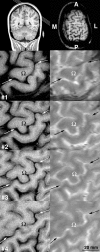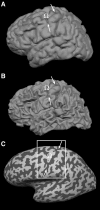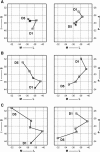Functional somatotopy of finger representations in human primary motor cortex
- PMID: 12632465
- PMCID: PMC6872002
- DOI: 10.1002/hbm.10084
Functional somatotopy of finger representations in human primary motor cortex
Abstract
To assess the degree of fine-scale somatotopy within the hand area of the human primary motor cortex (M1), functional mapping of individual movements of all fingers was performed in healthy young subjects (n = 7) using MRI at 0.8 x 0.8 mm2 resolution and 4 mm section thickness. The experimental design comprised both a direct paradigm contrasting single digit movements vs. motor rest and multiple differential paradigms contrasting single digit movements vs. the movement of another digit. Direct mapping resulted in largely overlapping activations. A somatotopic arrangement was only recognizable when considering the mean center-of-mass coordinates of individual digit representations averaged across subjects. In contrast, differential paradigms revealed more segregated and somatotopically ordered activations in single subjects. The use of center-of-mass coordinates yielded inter-digit distances ranging from 2.0 to 16.8 mm, which reached statistical significance for pairs of more distant digits. For the middle fingers, the functional somatotopy obtained by differential mapping was dependent on the choice of the digit used for control. These results confirm previous concepts that finger somatotopy in the human M1 hand area emerges as a functional predominance of individual digit representations sharing common areas in a distributed though ordered network.
Copyright 2003 Wiley-Liss, Inc.
Figures








Similar articles
-
Somatotopy in human primary motor and somatosensory hand representations revisited.Cereb Cortex. 2001 Apr;11(4):312-21. doi: 10.1093/cercor/11.4.312. Cereb Cortex. 2001. PMID: 11278194
-
Somatotopy in the human motor cortex hand area. A high-resolution functional MRI study.Eur J Neurosci. 1997 Oct;9(10):2178-86. doi: 10.1111/j.1460-9568.1997.tb01384.x. Eur J Neurosci. 1997. PMID: 9421177
-
Detailed somatotopy in primary motor and somatosensory cortex revealed by Gaussian population receptive fields.Neuroimage. 2018 Oct 1;179:337-347. doi: 10.1016/j.neuroimage.2018.06.062. Epub 2018 Jun 22. Neuroimage. 2018. PMID: 29940282 Free PMC article.
-
Constraints on somatotopic organization in the primary motor cortex.J Neurophysiol. 2001 Nov;86(5):2125-43. doi: 10.1152/jn.2001.86.5.2125. J Neurophysiol. 2001. PMID: 11698506 Review.
-
Somatotopic Mapping of the Fingers in the Somatosensory Cortex Using Functional Magnetic Resonance Imaging: A Review of Literature.Front Neuroanat. 2022 Jun 29;16:866848. doi: 10.3389/fnana.2022.866848. eCollection 2022. Front Neuroanat. 2022. PMID: 35847829 Free PMC article. Review.
Cited by
-
Delta waves as a sign of cortical plasticity after full-face transplantation.Sci Rep. 2024 Jul 16;14(1):16454. doi: 10.1038/s41598-024-67469-w. Sci Rep. 2024. PMID: 39014053 Free PMC article.
-
Selective BOLD responses to individual finger movement measured with fMRI at 3T.Hum Brain Mapp. 2012 Jul;33(7):1594-606. doi: 10.1002/hbm.21310. Epub 2011 Jun 14. Hum Brain Mapp. 2012. PMID: 21674691 Free PMC article. Clinical Trial.
-
Neuronal correlates of voluntary facial movements.Front Hum Neurosci. 2015 Oct 28;9:598. doi: 10.3389/fnhum.2015.00598. eCollection 2015. Front Hum Neurosci. 2015. PMID: 26578940 Free PMC article.
-
Motor Demands Constrain Cognitive Rule Structures.PLoS Comput Biol. 2016 Mar 11;12(3):e1004785. doi: 10.1371/journal.pcbi.1004785. eCollection 2016 Mar. PLoS Comput Biol. 2016. PMID: 26966909 Free PMC article.
-
Decoding individuated finger movements using volume-constrained neuronal ensembles in the M1 hand area.IEEE Trans Neural Syst Rehabil Eng. 2008 Feb;16(1):15-23. doi: 10.1109/TNSRE.2007.916269. IEEE Trans Neural Syst Rehabil Eng. 2008. PMID: 18303801 Free PMC article.
References
-
- Beisteiner R, Windischberger C, Lanzenberger R, Edward V, Cunnington R, Erdler M, Gartus A, Streibl B, Moser E, Deecke L (2001): Finger somatotopy in human motor cortex. Neuroimage 13: 1016–1026. - PubMed
-
- Dechent P, Frahm J (2000): Direct mapping of ocular dominance columns in human primary visual cortex. Neuroreport 11: 3247–3249. - PubMed
-
- Donoghue JP, Leibovic S, Sanes JN (1992): Organization of the forelimb area in squirrel monkey motor cortex: representation of digit, wrist, and elbow muscles. Exp Brain Res 89: 1–19. - PubMed
-
- Ferrier D. Experiments on the brain of monkeys. (1875): Proc R Soc London 23: 409–430.
-
- Foerster O (1936): The motor cortex of man in the light of Hughlings Jackson's doctrines. Brain 59: 135–159.
MeSH terms
LinkOut - more resources
Full Text Sources

